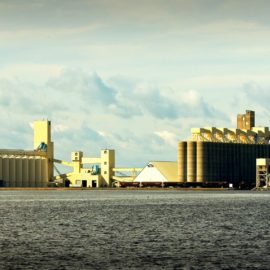
Air pollution is nothing new in this area but a new grain terminal will bring dust to the Baton Rouge – New Orleans corridor.
A Louisiana company wants to build a 36-silo grain terminal on the west bank of St. John the Baptist Parish, bringing more jobs and air pollution to the Mississippi River corridor between New Orleans and Baton Rouge. Greenfield Louisiana LLC of Baton Rouge says the 248-acre export terminal would employ 60 people in barge, dock, rail, truck, storage, processing and elevator operations for wheat, corn and soybeans. Some residents, and the ACLU of Louisiana, object that its operations and grain dust emissions would threaten the health and safety of neighbors.
nola.com
Considered a “minor” source of air pollution, no public comment period was planned. The company applied in May for their Air Quality Permit and received it in August.
Greenfield Louisiana anticipates emitting 81 tons of inhalable particulate matter measuring as large as 10 micrometers per year and 37 tons of fine particulate matter measuring as large as 2.5 micrometers per year. The terminal would also contribute 10 tons of carbon emissions annually. Particulate matter is comprised of small solid or liquid bits that can cause haze and penetrate deep into people’s lungs and bloodstream, potentially leading to respiratory and heart issues.
Community activist, Joy Banner, who lives in Wallace, is not happy.
Community activist Joy Banner, who lives in Wallace, said the terminal would worsen the area’s questionable air quality. “We already are inundated with chemicals, with smells, particulate matter from the other plants that rest across the river from us,” Banner said. “We have dust in our cars. We have dust in our houses. We have dust in our shoes.” Banner, whose aging parents also live in St. John Parish, looks to the experiences of Reserve residents who live across the Mississippi River near two grain elevators that caused respiratory problems and quality-of-life complaints in 2014. “They may be calling it minor, but, I’m sorry, minor according to who? They’re not living in the midst of it,” Banner said. “When I’m looking through the information, they’re not putting this in the context of a community that is already burdened with over pollution.”
Again a minority community is hit by the placement and it is close to Whitney Plantation which focuses on the lives of the slaves used there. Banner, who works for Whitney Plantation, said she spoke as a citizen not an employee.
In May, the Port of South Louisiana applied for a $25 million federal grant to help it build a dock for Greenfield Louisiana’s terminal. If approved by the U.S. Department of Transportation, the port would lease the dock to Greenfield. As the country’s largest grain port, the Port of South Louisiana currently handles more than half of the U.S. grain exports annually. The port said Greenfield’s terminal would create 300-plus jobs at peak construction and 70 to 100 permanent jobs. Greenfield’s air quality permit application anticipated 60 permanent jobs.
St. John Parish President Jaclyn Hotard and several council members favor the terminal on economic grounds. The ACLU opposes the plant nothing that grain elevators have dust explosions as well as the difficulties of working inside the elevators.
A public comment period on Greenfield’s applications for three government permits is now open. The start of the period happened to coincide with a call from United Nation human rights analysts to end environmental racism and halt further industrialization of the river parishes between Baton Rouge and New Orleans. Industrial interests call this stretch Louisiana’s chemical corridor; their opponents call it “Cancer Alley.” “Findings in a recent research report conducted by the United Nations human rights officials confirm that this stretch of our state is one of the most heavily polluted areas in the United States and the risk of cancer from air pollution in the corridor is 95% higher than in most of the country,” Odoms said. “We cannot afford any more harmful emissions released throughout these parishes. For the health and safety of all Louisianians, we urge the U.S. Army Corps of Engineers to reject this permit.
A related story on a dust explosion can be found here.
Banner, the community activist, plans to host a virtual community meeting about the project on Wednesday at 6:30 p.m. She can be called at (225) 206-1993. Written public comments may be submitted by March 31 to the Corps at 7400 Leake Ave., New Orleans 70118. They must include the applicant’s name and this project code: MVN 2014-01518-2 EMM. Written comments to the Department of Environmental Quality may be sent to P.O. Box 4313, Baton Rouge 70821 and must include the applicant’s name and this code: WQC 210201-01.
Based on the comments received, a public hearing may be called



